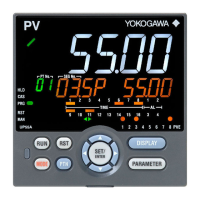6-32
IM 05P02C41-01EN
DescriptionandTuningofDerivativeTime
Ifthecontrolobjecthasalargetimeconstantordeadtime,thecorrectiveactionwill
be too slow with proportional action or proportional-plus-integral action alone, causing
overshoot.However,evenjustsensingwhetherthedeviationisonanincreasingora
decreasing trend and adding some early corrective action can improve the controllability.
Thus the derivative action (D action) is action that changes the output in proportion to the
deviation derivative value (rate-of-change).
The derivative time is defined as the time required with PD action to develop, when a
constant-slope change in deviation is imposed, an output change due to derivative action
that is exactly equal to the change due to proportional action.
Output = e + T
D
e
100
P
d
dt
P = 100%
Output change due to P action
Output change due to D action
Time
Derivative
Small
derivative time
Large
derivative time
e : Deviation
T
D
: Derivative time
Deviation
Output (%)
To manually tune the derivative time
• Adjustfromshortertimetolongertime.
• If you see a short-period oscillation, the time is too long.
The longer the derivative time set, the stronger the corrective action, and the more likely
theoutputwillbecomeoscillatory.Oscillationsduetoderivativeactionarecharacterized
by a short period.
D = OFF should always be used when controlling fast-responding inputs such as
pressureandflowrate,orinputscharacterizedbyrapidfluctuation,suchasoptical
sensors.
Time
SP
• If D is too large, short-period oscillation will appear in
the measured temperature.
6.3AdjustingPIDManually

